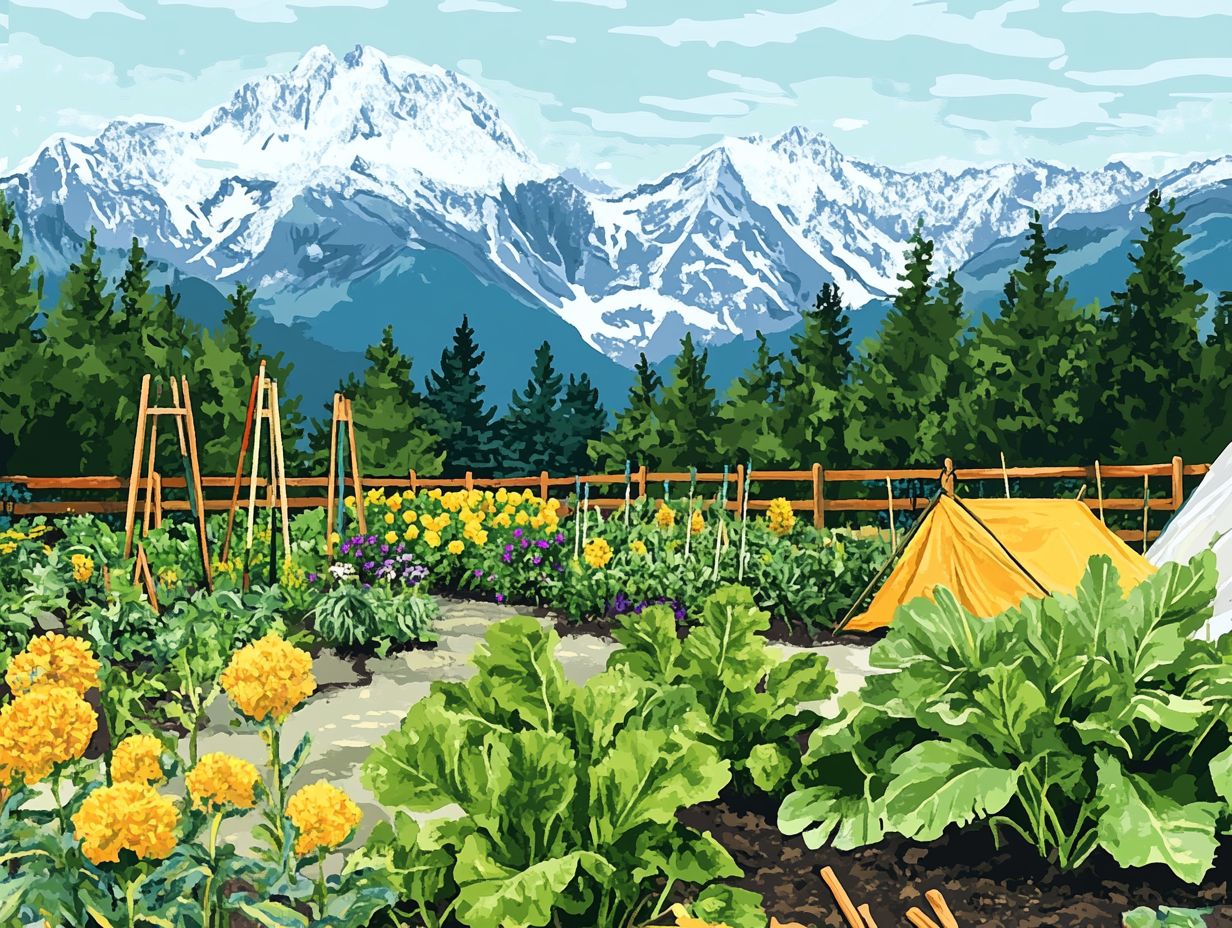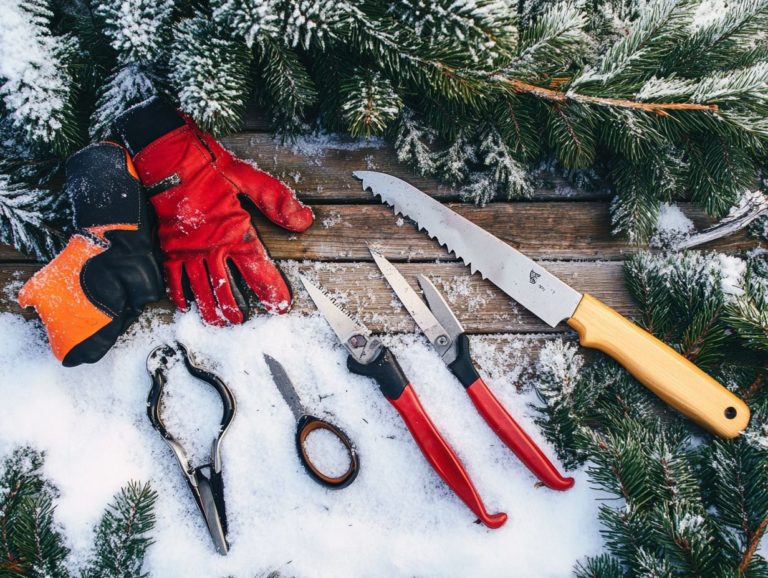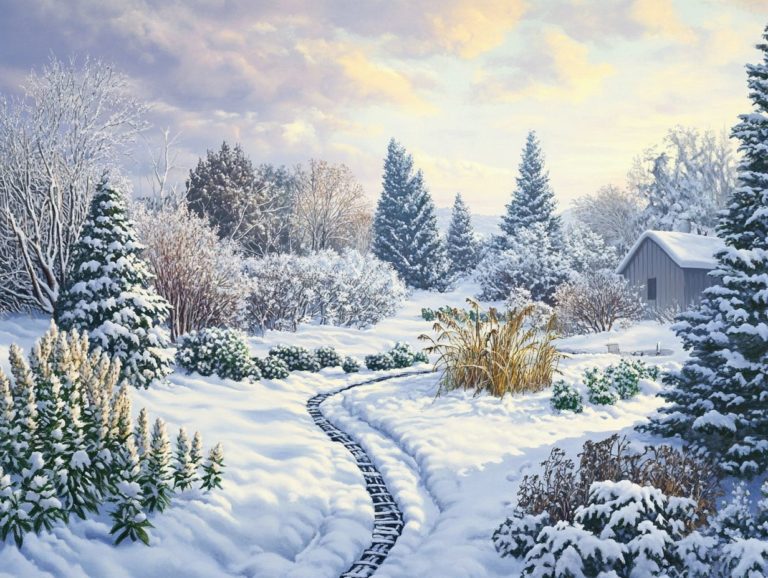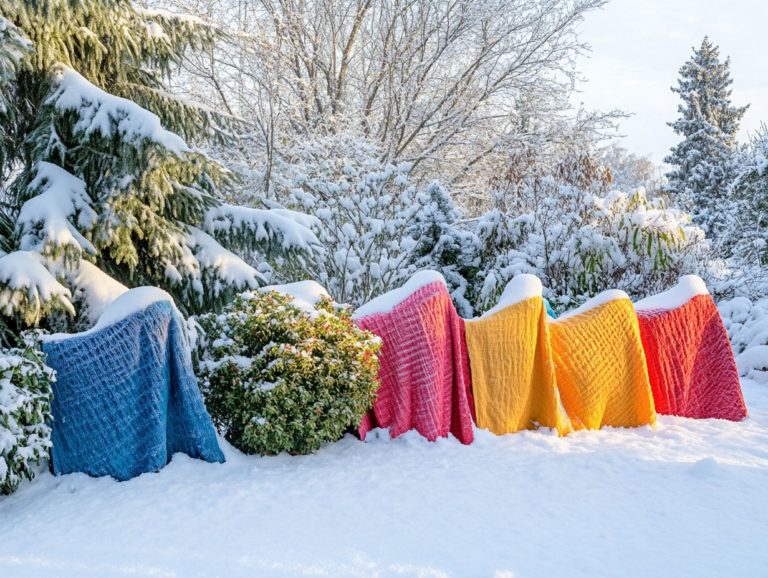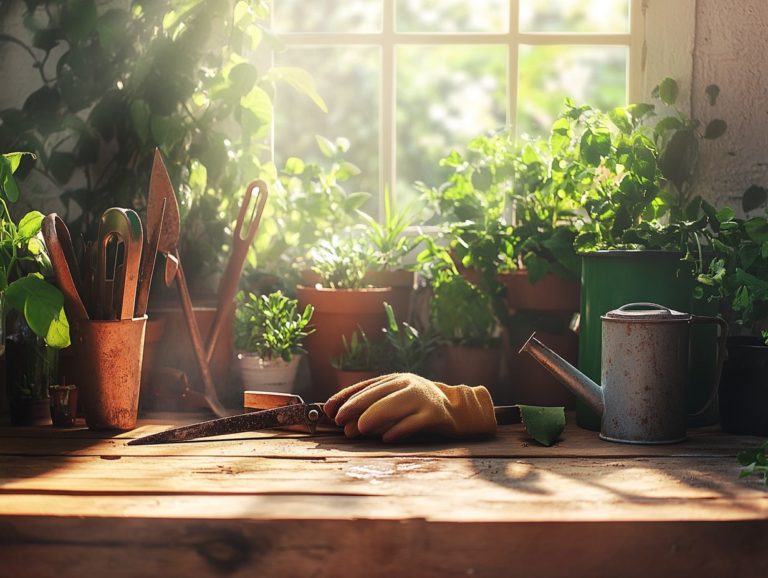Top 10 Plant Protectors for Cold Climates
As winter draws closer, it is crucial for you to safeguard your garden from the impending chill!
Here are the top 10 plant protectors that will help your green companions thrive, even in the coldest conditions. Ranging from simple mulching techniques to sophisticated greenhouses, each option presents unique benefits to ensure your plants withstand harsh weather.
Discover how these protectors function. Learn about common mistakes to steer clear of and gather tips to prepare your garden for the frosty months ahead.
Transform your garden into a winter haven!
Contents
- Key Takeaways: Protect Your Plants
- 1. Mulch
- 2. Fleece or Frost Blankets
- 3. Cold Frames
- 4. Cloches
- 5. Row Covers
- 6. Greenhouses
- 7. Windbreaks
- 8. Heated Propagators
- 9. Water Walls
- 10. Cold-Hardy Plants
- What Are the Different Types of Plant Protectors?
- Frequently Asked Questions
- What are the top 10 plant protectors for cold climates?
- What is a frost blanket and how does it protect plants in cold climates?
- How does winter mulch help protect plants in cold climates?
- What are garden cloches and how do they protect plants in cold climates?
- Do row covers provide effective protection for plants in cold climates?
- Can cold frames be used to protect plants in cold climates?
- Are greenhouses a good option for protecting plants in cold climates?
- Do wind barriers help protect plants in cold climates?
- What are insulated covers and how do they protect plants in cold climates?
- Can heat lamps be used to protect plants in cold climates?
Key Takeaways: Protect Your Plants
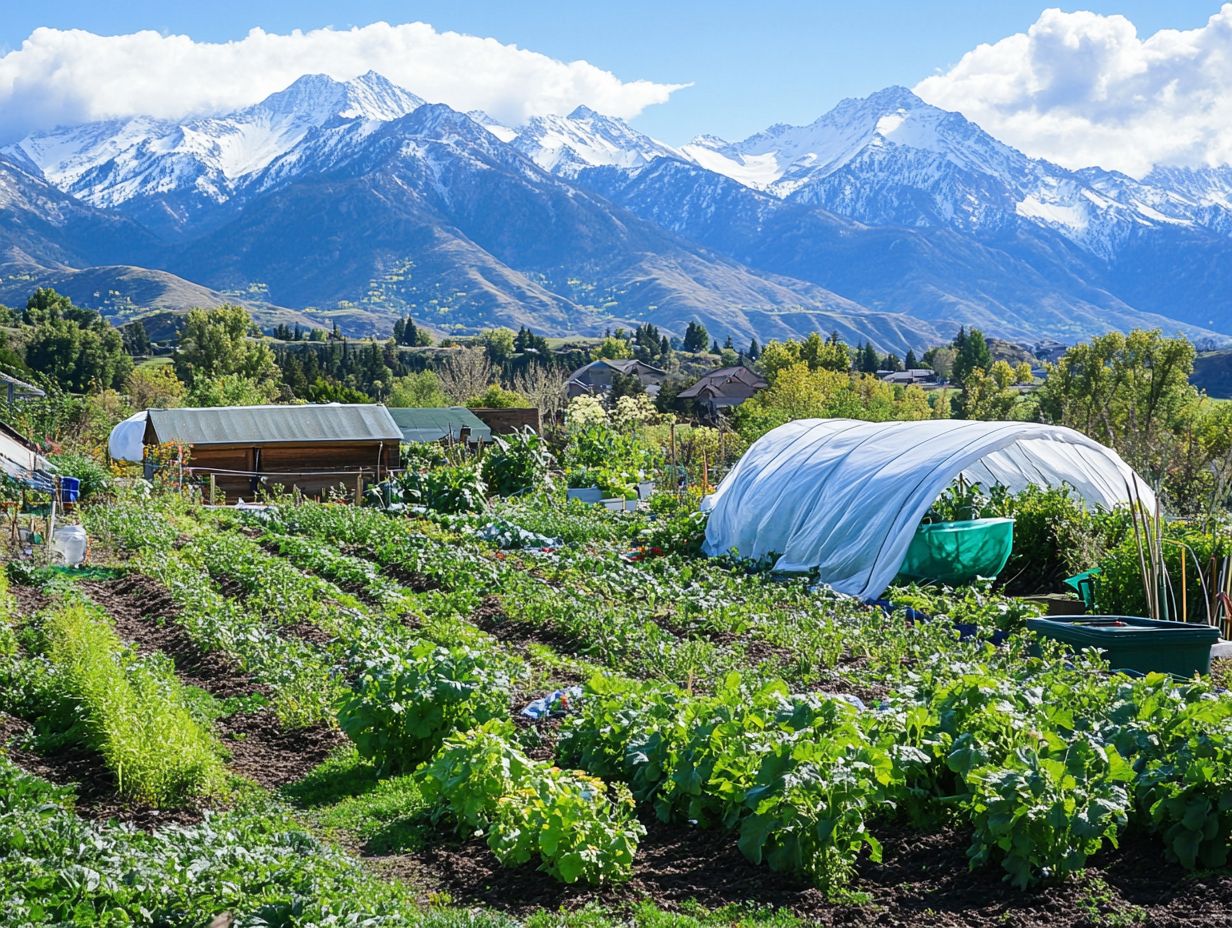
- Mulch is an effective and affordable way to protect plants from cold temperatures by insulating their roots and retaining moisture.
- Using fleece or frost blankets can provide a barrier against freezing temperatures and wind while still allowing sunlight and airflow to reach the plants.
- Cold frames offer a more permanent solution for protecting plants in cold climates and can be used to extend the growing season.
1. Mulch
Mulching is a vital practice in winter gardening. It delivers a host of benefits, including moisture retention, temperature regulation, and protection against weeds and frost.
This ensures your plants not only survive but thrive throughout the colder months and into the growing season.
By applying organic mulch, you nourish the soil and enhance its structure. This creates a hospitable environment for plant growth, all while simplifying your garden maintenance.
Consider using organic mulch types like:
- shredded leaves
- straw
- wood chips
These materials provide insulation. As they decompose over time, they enrich the soil with essential nutrients.
When utilized effectively, mulch serves as a protective barrier against harsh weather. It minimizes the risk of winter burn, which is damage caused by extreme cold, by stabilizing soil temperature and moisture levels.
For optimum results, aim for a 2-4 inch layer of mulch. Ensure it’s a few inches away from plant stems to prevent rot.
Regularly refreshing this layer can significantly boost its protective qualities and contribute to the overall health of your garden.
2. Fleece or Frost Blankets
Fleece or frost blankets are essential tools for protecting your plants during the chilly early spring and late winter months.
They provide a cozy insulating layer that traps heat while still allowing for necessary air circulation. This effectively prevents winter burn and fosters healthy growth.
These lightweight and breathable materials are expertly designed to cover tender plants. They keep them warm without risking suffocation.
To ensure maximum effectiveness, securing the blankets properly is vital, especially in windy conditions. Using stakes or weights will prevent them from becoming airborne.
In colder climates, consider double-layering these blankets on particularly vulnerable plants for added protection. In milder areas, a single layer may be sufficient.
On warmer days, it s a good idea to remove the blankets to avoid overheating. This allows sunlight and essential moisture to reach your plants, promoting optimal growth.
3. Cold Frames
Cold frames present an exceptional solution for extending your growing season.
By using the natural warmth of the sun, they create a warm microclimate that nurtures your seedlings and shields your plants from the harshness of winter.
For those who are passionate about winter gardening, cold frames become a critical ally.
Regarding construction materials, you have options wood, PVC, or even recycled windows. This allows you to customize your cold frame for peak functionality.
Your designs can range from simple, low structures to more intricate setups featuring slanted tops that maximize sunlight absorption.
Cold frames create an ideal environment for starting seedlings. They also offer a sanctuary for tender plants, protecting them from unexpected frosts.
Whether you’re propagating herbs, hardening off young plants, or nurturing delicate flowers, these versatile structures ensure that your gardening endeavors can continue seamlessly throughout the seasons.
Get started on these methods today to ensure your garden flourishes all winter long!
4. Cloches
Cloches are great at protecting plants, providing a crucial shield against bad weather for your sensitive seedlings and emerging plants. They ensure warmth and safeguard against frost, promoting faster germination and growth even during unpredictable weather spells.
There are various types of cloches available, each tailored to meet your specific gardening needs. Glass cloches excel in insulation while allowing sunlight to nourish your plants, making them perfect for tender varieties. Meanwhile, plastic cloches are lightweight and come in numerous designs, from simple domes to hoop varieties that can cover entire rows of plants.
For the best protection from cloches, place them strategically, ensuring there s adequate air circulation to prevent overheating and moisture buildup. Regular maintenance like cleaning and pest checks is essential for maintaining their effectiveness, especially through the colder months.
5. Row Covers
Row covers are your secret weapon for plant protection, acting as effective barriers that not only insulate your plants during chilly days but also provide pest control benefits. They are important tools for all types of gardening.
These covers come in various types, mainly distinguished by their materials, such as spunbond polyester, polypropylene, and woven fabrics. Spunbond covers are lightweight and breathable, allowing sunlight and moisture to filter through while shielding your plants from harsh winds and frosts. If you’re looking for excellent insulation, polypropylene covers are the way to go they’re perfect for safeguarding tender seedlings from pesky late spring chills.
To make the most of your row covers, secure them with hoops or stakes, ensuring they re firmly in place during windy or rainy weather. Just be sure to maintain enough height to keep them from touching your plants. Regularly checking for moisture and ventilation will also help you optimize plant health and yield throughout the growing season.
6. Greenhouses
Greenhouses present an exceptional solution for attaining optimal gardening conditions throughout the year, harnessing the greenhouse effect to maintain stable temperatures and protect your plants from winter’s chill. This not only enhances your garden maintenance but also ensures a productive growing season.
With the capability to regulate humidity and shield delicate plants from severe weather, these structures provide a controlled environment that fosters healthy growth. You can implement effective pest management strategies within a greenhouse, significantly reducing your reliance on harmful pesticides.
There are various designs available, from classic Victorian styles to sleek, modern structures, all of which can be customized to meet your specific gardening needs and preferences. Whether you wish to cultivate tropical herbs or seasonal vegetables, the versatility of greenhouses enables you to adopt a tailored approach that maximizes productivity and sustainability, making it easier for you to enjoy a bountiful harvest year-round.
7. Windbreaks

Windbreaks are vital for providing weather protection in your gardens and landscapes. They act as barriers that reduce windspeed, creating a more favorable microclimate for your plants, which enhances their growth potential and overall resilience during harsh winter months.
You should craft these protective structures from various natural elements, like trees or shrubs, which not only shield your vulnerable plants from gusts but also provide habitat for beneficial wildlife. Alternatively, consider artificial options like fences or trellises, which can be strategically installed to serve similar purposes.
Know the wind patterns and thoughtfully place these barriers to significantly reduce soil erosion and moisture loss. This well-considered arrangement simplifies your gardening maintenance and fosters a thriving ecosystem, ensuring your plants receive ideal conditions to flourish.
Start building your windbreak today to give your plants the best chance this winter!
8. Heated Propagators
Heated propagators create an ideal space for seed germination and plant propagation. This is especially helpful in winter when you can control soil temperature for better growth.
By keeping the propagator warm, you can mimic the beneficial conditions of spring. This encourages quicker sprouting and stronger seedlings.
When selecting the right model, consider factors like size, wattage, and temperature controllers that help maintain the right warmth.
Regularly monitoring soil temperature is essential; ideally, it should stay between 70 F and 75 F for most seeds. Ensure proper ventilation to prevent excess humidity, which can invite fungal issues.
Using heated propagators can lead to plants that burst with life when you finally plant them outside!
9. Water Walls
Water walls are innovative insulation techniques for your garden. They harness stored solar heat to create a stable temperature environment, shielding your plants from extreme cold.
These structures function like thermal mass collectors. They soak up sunlight during the day and gradually release it at night, helping moderate temperature fluctuations.
By incorporating a water wall into your garden setup, you can significantly enhance your growing conditions, especially in areas prone to harsh winters.
Some benefits of using water walls include:
- Improved humidity levels, vital for certain plants.
- Potential reduction in heating costs.
For effective installation, choose materials with high thermal conductivity. Position your water wall to optimize sunlight exposure throughout the day.
10. Cold-Hardy Plants
Cold-hardy plants are your best choices for a thriving winter garden, including the top 5 shrubs for cold-climate gardens. They are designed to withstand lower temperatures and frost.
Consider varieties like winter jasmine, hellebores, and certain types of kale. These resilient selections not only demonstrate impressive hardiness but also add beauty and functionality to your landscape.
Cold-hardy plants thrive in unpredictable weather, proving their ability to endure and flourish even when wrapped in a snowy blanket.
As you select these plants, keep their specific needs in mind, such as soil type and sunlight exposure. Offering adequate mulch and wind protection can significantly boost their chances of survival.
These measures ensure that your plants reach their full potential while still providing visual allure throughout the colder months.
What Are the Different Types of Plant Protectors?
In the world of winter gardening, you have various plant protectors at your disposal. To enhance your efforts, consider the top 5 planters for cold-climate gardening. Each tool is designed to provide essential weather protection and insulation.
Consider mulches, which retain moisture and regulate soil temperature, acting as a formidable barrier against extreme cold. Additionally, you might find the top 5 tips for planting in cold climates helpful, as frost blankets are another excellent option, shielding delicate foliage from icy winds and frost damage while trapping heat close to your plants.
Cloches, often made of glass or plastic, create a mini-greenhouse effect, nurturing warmer microclimates for your seedlings and young plants. Row covers protect entire sections of your garden from pests while ensuring light and air circulation remain intact.
When you combine these tools, you enhance plant survival rates and set the stage for gardening success through improved growth conditions.
Explore these plant protector options today to give your garden the best chance this winter!
How Do These Plant Protectors Work?
Plant protectors use various insulation methods and materials. They create a strong barrier against harsh weather, keeping your plants safe from frost, wind, and temperature changes, especially when choosing the top 10 plants for small cold-climate balconies.
These protective devices feature materials like burlap, frost cloth, or specialized plant covers. They trap heat generated by the soil, preventing it from escaping into the cold air. By reflecting sunlight during the day and retaining warmth at night, they create a warm area around the plants that helps them grow better.
Some plant protectors even incorporate PVC, a type of plastic used for covering, or polyethylene sheeting. This acts as a moisture barrier, reducing the risk of ice formation while maintaining optimal moisture levels.
Strategically placing these protectors is essential. They shield your plants while promoting air circulation to prevent fungal growth. For those gardening in colder regions, consider incorporating the top 5 shade-tolerant plants for cold climates. This ensures your garden continues to thrive even amidst winter’s chill.
What Are the Benefits of Using Plant Protectors?
Utilizing plant protectors brings a wealth of advantages. They safeguard your plants against frost and pests, creating optimal growth conditions during winter gardening. For those looking to enhance their gardens, consider the top 10 plants for fall color in cold climates.
These protective measures act as a barrier, minimizing damage from environmental factors like harsh winds, excessive rain, and sudden temperature shifts. For those gardening in colder regions, incorporating the top 5 ground covers for cold climates can be essential. By maintaining ideal conditions, plant protectors foster robust root development and promote overall vitality.
If you’re passionate about gardening, using these strategies not only shields your cherished plants but also nurtures a thriving ecosystem that champions sustainability. In essence, plant protectors are a critical tool in your gardening arsenal.
What Are the Common Mistakes When Using Plant Protectors?
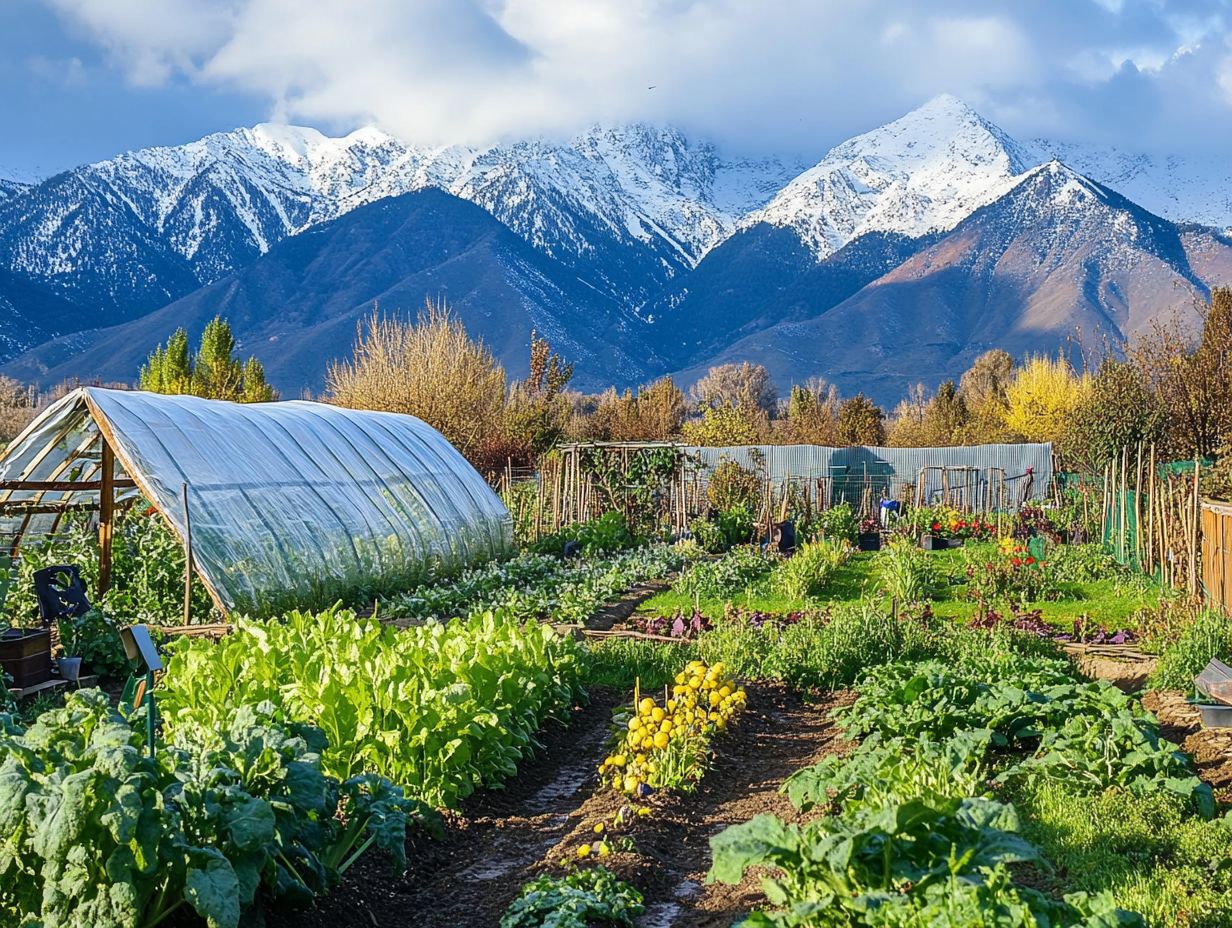
Common mistakes in using plant protectors can undermine their effectiveness. This jeopardizes your winter gardening efforts. It s vital to understand best practices and avoid common mistakes!
One frequent error is improper installation. Failing to secure plant protectors correctly allows cold air or pests to invade. Additionally, uneven or insufficient coverage can leave some plants vulnerable while overprotecting others, resulting in uneven growth.
Timing is also crucial. Using protectors too early can trap excess moisture, leading to rot, while waiting too long might expose tender plants to harsh conditions.
To enhance your gardening outcomes, ensure that protectors fit snugly around your plants. Consistently assess the coverage area and keep an eye on weather forecasts for optimal installation timing.
How Can One Prepare Their Plants for Cold Weather?
Preparing your plants for cold weather requires a thoughtful approach. This enhances their resilience against frost and winter burn, ensuring they remain healthy and vibrant during the challenging winter gardening season.
One effective strategy is applying a generous layer of mulch around the base of your plants. This insulates the soil and helps retain moisture, giving your plants a fighting chance against the chill.
Consider using burlap to protect delicate foliage from harsh winds and frost damage. It acts as a shield against the elements.
You can also use windbreaks, like shrubs or fences, to reduce wind exposure significantly and create a more sheltered environment for your plants.
For optimal results, monitor soil moisture levels and ensure your plants are well-hydrated before frost sets in. This attentive care will significantly enhance their chances of thriving through the colder months.
What Are Some Additional Tips for Protecting Plants in Cold Climates?
In cold climates, enhancing your winter gardening strategy with plant protection tips can make all the difference. To optimize your efforts, consider incorporating the top 10 winter vegetables for cold climates, which will help ensure your plants not only survive but thrive, even in the harshest conditions.
One effective approach is to use heated propagators. These create a warm space for your seedlings, enabling them to grow robustly despite the chill outside. You can also incorporate water walls around your garden, which stabilize temperatures by reflecting sunlight during the day and retaining warmth at night.
Regular maintenance is vital. Be sure to check for pests, promptly clear away debris, and ensure proper drainage to prevent issues like root rot and frostbite. By nurturing these practices, you can cultivate a resilient landscape that endures the winter months and flourishes beautifully in the spring.
Frequently Asked Questions
What are the top 10 plant protectors for cold climates?
- Frost blankets
- Winter mulch
- Garden cloches
- Row covers
- Plant covers
- Cold frames
- Greenhouses
- Wind barriers
- Insulated covers
- Heat lamps
What is a frost blanket and how does it protect plants in cold climates?
A frost blanket is a lightweight fabric cover placed over plants to protect them from frost and freezing temperatures. It traps the heat from the soil and air, creating a warmer space for the plants.
How does winter mulch help protect plants in cold climates?
Winter mulch is a layer of organic material, such as straw or shredded leaves, placed around the base of plants. It helps insulate the soil and protect the roots from freezing temperatures.
What are garden cloches and how do they protect plants in cold climates?
Garden cloches are individual covers that you can place over single plants or small groupings of plants. They create a mini greenhouse effect, trapping heat and protecting plants from frost and freezing temperatures.
Do row covers provide effective protection for plants in cold climates?
Yes, row covers are lightweight fabric that you can drape over rows of plants. They provide a barrier against frost and freezing temperatures while allowing sunlight and water to reach the plants.
Can cold frames be used to protect plants in cold climates?
Yes, cold frames are small, unheated structures that protect plants from cold temperatures. They are often used to extend the growing season in colder climates and can also help overwinter plants.
Are greenhouses a good option for protecting plants in cold climates?
Yes, greenhouses are an excellent option for protecting plants in cold climates. They provide a controlled environment, keeping plants warm and protected from frost and freezing temperatures.
Do wind barriers help protect plants in cold climates?
Yes, wind barriers, like fences or hedges, can protect plants from strong winds that can damage or kill them in cold climates. They create a cozy shelter for your plants!
What are insulated covers and how do they protect plants in cold climates?
Insulated covers are made from materials such as foam or bubble wrap. You place them over plants to provide an extra layer of insulation. They help trap heat and protect plants from cold temperatures.
Can heat lamps be used to protect plants in cold climates?
Yes, heat lamps provide extra warmth for plants in cold climates. They work best in a greenhouse or enclosed space to keep the temperature warm and consistent.
Start protecting your plants today with these tips to ensure they thrive even in the cold!

